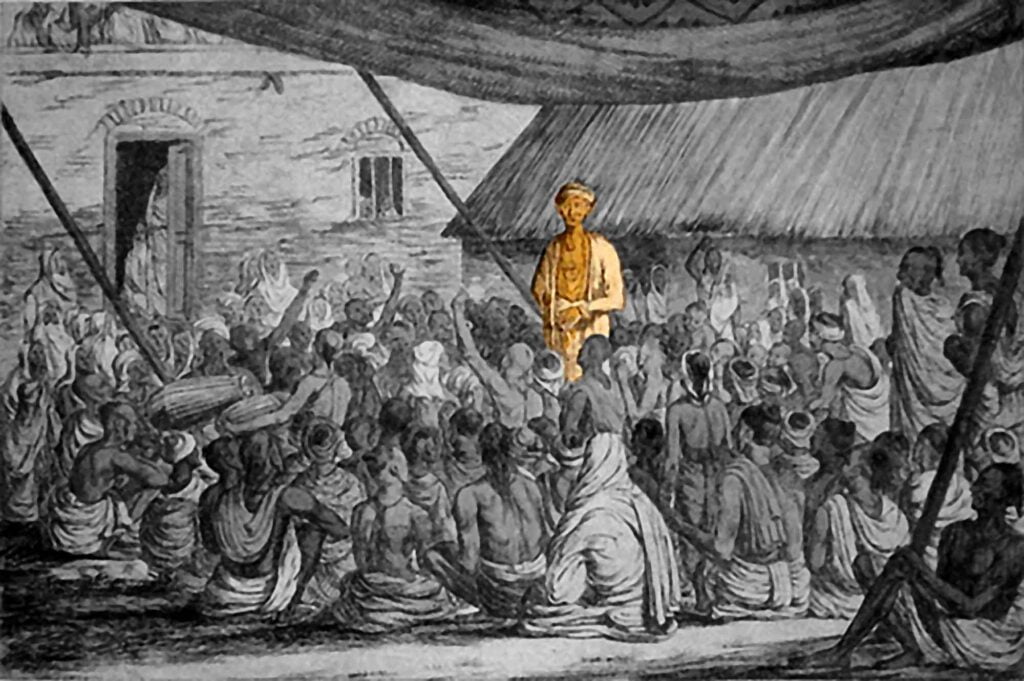Overview
Sad-guṇa and Bhakti was first published in 1893, in Volume 5 of Sajjana Toṣaṇī, this article describes the many auspicious qualities found in the personality of a Vaiṣṇava, and Bhaktivinoda Ṭhākura points out how all such qualities naturally appear wherever bhakti is found.
(translated by Gaudiya Vedanta Publications)
In the book Śrī Hari-bhakti-rasāmṛta-sindhu, auspiciousness (śubhadtva) has been described as one of the six glories of bhakti. The question, “How many kinds of auspiciousness are there?” is answered as follows:
śubhāni prīṇanaṁ sarva-jagatām anuraktatā
sad-guṇāḥ sukham ity ādīny ākhyātāni manīṣibhiḥ
“Learned sages have described the meaning of auspiciousness as love for the entire creation, caring affection for all living entities, saintly character, happiness, and other such qualities.” (Bhakti-rasāmṛta-sindhu, Eastern Division, Sādhana-lahari 28)
The person in whom bhakti has arisen bestows affection to the whole world and becomes the object of attachment for everyone in the world. He effortlessly becomes the recipient of all saintly qualities and attains all types of pure happiness and auspiciousness. Learned scholars have described all these attributes as symptoms of auspiciousness. The following words of the Bhāgavata describe that devotee who possesses all good qualities:
yasyāsti bhaktir bhagavaty akiñcanā
sarvair guṇais tatra samāsate surāḥ
harāv abhaktasya kuto mahad-guṇā
mano-rathenāsati dhāvato bahiḥ
“One who has unflinching devotion for the Supreme Personality of Godhead has all the good qualities of the demigods. But one who is not a devotee of the Lord has only material qualifications that are of little value. This is because he is hovering on the mental plane and is certain to be attracted by the glaring material energy.” (Śrīmad-Bhāgavatam 5.18.12)
All good qualities along with the devatās take shelter of that person who has akincanā-bhakti for Bhagavān. How can all good qualities appear in a nondevotee whose mind always runs towards temporary worldly affairs? The Skanda Purāṇa states:
ete na hy adbhutā vyādha tava hiṁsādayo guṇāḥ
hari-bhaktau pravṛttā ye na te syuḥ para-tāpinaḥ
“O hunter! Good qualities, like non-violence, which you have developed, are not very astonishing, for those who are engaged in hari-bhakti are by nature never inclined to give pain to others.”
antaḥ-śuddhir bahiḥ-śuddhis tapaḥ-śānty-ādayas tathā
amī guṇāḥ prapadyante hari-sevābhikāminām
Internal and external purity, austerity, peacefulness and so on, take shelter of a person desiring to serve Hari.
A list of good qualities has been compiled in Śrī Caitanya-caritāmṛta:
kṛpālu, akṛta-droha, satya-sāra sama
nirdoṣa, vadānya, mṛdu, śuci, akiñcana
sarvopakāraka, śānta, kṛṣṇaika-śaraṇa
akāma, nirīha, sthira, vijita-saḍ-guṇa
mita-bhuk, apramatta, mānada, amānī
gambhīra, karuṇa, maitra, kavi, dakṣa, maunī
“Devotees are always merciful, humble, truthful, equal to all, faultless, magnanimous, mild and clean. They are without material possessions, and they perform welfare work for everyone. They are peaceful, exclusively surrendered to Kṛṣṇa, and desireless. They are indifferent to material acquisitions and fixed in devotional service. They completely control the six bad qualities: lust, anger, greed and so forth. They eat only as much as required, and they are not inebriated. They are respectful, grave, compassionate and without false prestige. They are friendly, poetic, expert and silent.” (Śrī Caitanya-caritāmṛta, Madhya 22.78–80)
All these good qualities accompany bhakti. Now the following question arises: Does Bhakti-devī manifest after the appearance of all these qualities, or do all these good qualities take shelter of the bhakta in whom bhakti appears?
The above question is answered as follows. According to the bhakti-śāstras a jīva develops faith in bhakti on the strength of sukṛti caused by a desire to perform bhakti. On attaining faith in bhakti, the jīva takes shelter at the feet of a sādhu and engages in bhajana. Immediately before engaging in bhajana, many anarthas, meaning those things that are opposed to good qualities, remain in him. By the strength of bhakti and sadhu-saṅga, all anarthas effortlessly melt away while performing bhajana, and in their place all good qualities naturally arise. Until anarthas are annihilated and auspicious qualities manifest, one remains on the stage of bhajanābhāsa or nāmābhāsa. As one performs śuddha-bhajana, that is, chants śuddha-nāma, anarthas are destroyed and simultaneously saintly qualities manifest. At this time, the sādhaka has no taste for sinful activities or anarthas. For this reason Śrī Mahāprabhu said:
eka kṛṣṇa-nāme kare sarva-pāpa kṣaya
nava-vidhā bhakti pūrṇa nāma haite haya
“Simply by chanting the holy name of Kṛṣṇa once, a person is relieved from all the reactions of a sinful life. One can complete the nine processes of devotional service simply by chanting the holy name.” (Śrī Caitanya-caritāmṛta, Madhya 15.107)
All the good qualities, such as jīve-dayā (mercy to all living entities), niṣpāpatā (a non-sinful nature), satyasāratā (truthfulness), samadarśitva (equal vision), dainya (humility), śānti (peacefulness), gāmbīrya (gravity), saralatā (simplicity), maitrī (amiability), daksatā (expertise), asat-kathāy audasīnya (indifference to mundane talk), pavitratā (purity), tucchakāma tyāga (the renunciation of useless work) and many others, naturally arise along with the appearance of kṛṣṇa-bhakti. It is not for the bhakta to attempt to attain other qualities separately from performing bhajana. The cultivation of śuddha-bhakti is indeed sufficient to achieve this. By cultivating śuddha-bhakti, anarthas are quickly destroyed and auspicious qualities are quickly awakened.
To cultivate the traditional practices of yoga such as yama, niyama, pratyāhāra and so on, is troublesome; and success, which only comes after a long period of practice, is checked by unwanted obstructions. As long as the jīva does not develop faith leading to bhakti, known as bhakti-unmukhī śraddhā, the determination to develop these qualities of the yoga path remains in him. Therefore only by performing bhajana in the association of a sādhu will all good qualities appear in that person in whom śraddhā has arisen. Auspicious qualities are cultivated on the paths of yoga and morality but a bhakta does not need to separately cultivate them. Persons on other paths may attain all good qualities, but in the absence of bhakti, these qualities are like many ornaments on an ugly lady, and can never actually be beautiful. On the other hand if, by the mercy of a sādhu, they fortunately gain bhakti-unmukhī śraddhā, they will undoubtedly perform sādhana immediately to achieve uttamā-bhakti.
O brothers who are filled with good qualities! Do not waste your time uselessly. Please make your life and dharma successful by taking shelter of the lotus feet of a devotee. This is the highest fruit of whatever auspicious qualities you have attained. It is incorrect to think that just by accumulating auspicious qualities one will get bhakti. Auspicious qualities will automatically appear in a person who has bhakti. One may have all auspicious qualities other than having taken onepointed shelter of Kṛṣṇa (kṛṣṇaikaśaraṇa), but until he develops faith in bhakti, he will not attain bhakti. Without possessing kṛṣṇa-bhakti, even auspicious qualities are not glorious. You should know that the life of a jīva who is endowed with all auspicious qualities but bereft of kṛṣṇa-bhakti, is useless.













